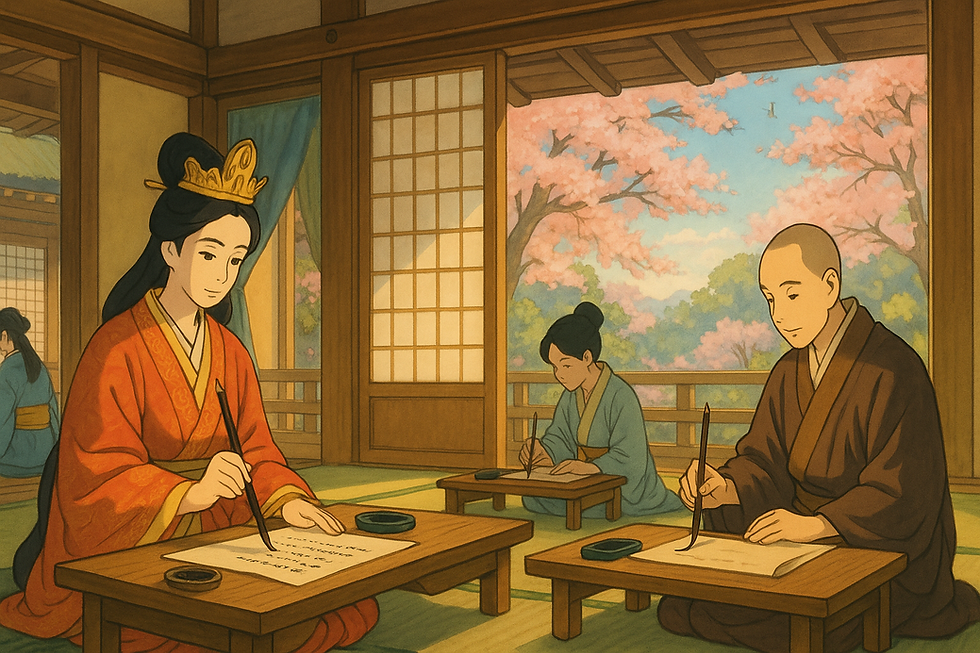Empress Suiko and Japanese Calligraphy — Why Its Spiritual Depth and Diversity Continue to Thrive Today
- 清水 芳樹
- 5月31日
- 読了時間: 2分

Japanese calligraphy is not only deeply rooted in history — it also lives on in various forms today. At the heart of its enduring spirit and aesthetics lies the cultural foundation established during the reign of Empress Suiko (554–628). In this final installment, we explore the legacy of calligraphy nurtured under Empress Suiko, the spiritual culture that continues into the modern era, and the growing global fascination with Japanese calligraphy.
Calligraphy as a Reflection of the Heart — A Legacy of Empress Suiko
In Empress Suiko’s time, the integration of Buddhism into society fostered a culture of writing with sincerity and mindfulness. In the act of sutra copying, characters were not merely transcribed — each one carried the scribe’s devotion and honest heart. This idea, that “calligraphy is a mirror of the heart,” gave rise to the unique spiritual dimension of Japanese calligraphy.
At temples and within the court, calligraphy became a means of self-discipline and spiritual harmony. Writing was seen as a way to calm the mind and refine one’s inner self — values that would shape Japanese aesthetics for centuries to come.
The Blossoming of Diversity and Individual Expression
After Empress Suiko’s reign, Japanese calligraphy blossomed into a multitude of styles and expressions. A culture of women writing poems and letters in delicate kana scripts emerged, leading to the rise of female calligraphers and the flourishing of kana literature during the Heian period.
Calligraphy evolved to serve a wide range of purposes — from sutras and poetry to historical records and official documents — each requiring unique brush techniques and styles. This emphasis on personal expression and emotional nuance became one of the hallmarks of Japanese calligraphy.
Why Japanese Calligraphy Endures in Modern Society
Even today, Japanese calligraphy remains deeply integrated into everyday life — from school lessons and New Year’s kakizome to exhibitions and the sharing of works on social media. The practice continues to provide moments of quiet focus and reflection through activities like shakyō (sutra copying) at Zen temples and workshops abroad.
The enduring appeal of Japanese calligraphy stems from the values cultivated in Empress Suiko’s era: writing with care, embracing diversity, and cherishing individuality.
Japanese Calligraphy Reaches the World
In recent years, Japanese calligraphy has gained international acclaim. More foreigners are becoming practitioners and enthusiasts, drawn to its ability to embody Japanese spiritual and aesthetic sensibilities. As an art form that “communicates the heart beyond words,” calligraphy has become a bridge across cultures and languages.
Empress Suiko’s Enduring Legacy in Modern Calligraphy
Perhaps Empress Suiko’s greatest achievement was instilling a society-wide appreciation for cultural cultivation and the value of heartfelt expression. Under her influence, calligraphy evolved into more than just a skill — it became a vessel for the spirit, individuality, and emotion.
Through modern Japanese calligraphy, we continue to experience the calm, focus, diversity, and richness of spirit that originated in Empress Suiko’s time.
Conclusion
The calligraphy fostered during Empress Suiko’s reign is a treasure of Japanese culture, embodying both spirituality and diversity.As we continue to practice and share calligraphy today, we are reminded of the timeless importance of writing with sincerity and expressing our unique selves — a tradition we can proudly carry into the future.
Experience authentic Japanese calligraphy:



Comentarios